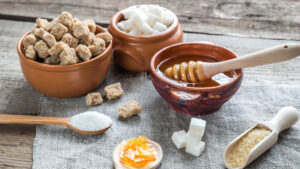Interview with Dr. med. univ. Dominik Klug, Austrian health coach, author and speaker.
What are healthy sugars and do they even exist? How do different types of sugar affect the body? What are the risks of sugar overconsumption? What role does blood sugar level play in health? What can I do for a healthy blood sugar level?
Sugar consumption is still a socially underestimated risk to health. Overconsumption carries the risk of insulin resistance, which in turn can lead to other diseases, some of them severe and chronic, including diabetes, metabolic syndrome, obesity, endometriosis, fibroids, PCOS and numerous other inflammatory diseases. Tigovit founder Tanja Hohenester spoke with health expert Dr. med. univ. Dominik Klug to get to the bottom of important questions about types of sugar, insulin, diabetes and co.. (Link Video)
An unavoidable topic that must be addressed for the long-term optimisation of health as well as for the prevention of diabetes and co. is the (correct) consumption of sugar and a healthy blood sugar level that is as constant as possible. Sugar consumption in modern, western society is far too high, and the trend is growing. Sugar is not only found in obviously sugary foods such as soft drinks, white flour products, sweets, cakes and chocolate, but also hidden in numerous products in the supermarket in which no sugar is actually to be expected.
Everything used to be better - Hardly any sugar in the Stone Age
Sugar was not always there, certainly not in the refined form of industrial sugar as it is today. "In the past, our ancestors did have access to sugar, but only in the form of fructose contained in fruits. Moreover, availability was naturally limited for several reasons, whereas today there is a dramatic oversupply," the expert explains.
For one thing, the fruits were only available seasonally, not in large quantities throughout the year. For another, it was only trichromatic vision, learned over years, that made it possible at all to get at the nutrient-rich source of sugar and to recognise the fruit as ripe, such as red berries against a green background.
In the past, this was followed by a reward from the body. The sweet, nutrient-rich taste experience triggers the release of the happiness hormone dopamine in the body, which is also responsible for feelings of addiction.
Until a few hundred years ago, however, classical sugar was virtually non-existent, which is why the body has not yet adapted to this new sugar.
What are "classic" sugars?
According to Dr Klug, classic sugars include the following types of sugar:
- White sugar
- Brown sugar
- Cane sugar
- Coconut blossom sugar
Here, Dr Klug advises caution against misleading marketing promises. Contrary to many advertising claims or packaging that present coconut blossom sugar as supposedly healthy or not a real sugar, this type of sugar triggers exactly the same reaction to the glucose it contains as white or brown sugar, even though coconut blossom sugar, unlike industrial sugar, has a lower glycaemic index and contains slightly more nutrients. "In the end, the pancreas does not care about the type of sugar. It always reacts by releasing insulin".sums up the health coach. "The hormone insulin ensures that sugar is absorbed from the blood into the cells."
The metabolic pathway of the simple Fruit sugar Fructose is insulin-independent, but there are also people who react to an excess of fructose and are exposed to strong blood sugar fluctuations. Too much fruit and dried fruit can therefore also cause damage.
Other types of sugar are Galactose and Tagatose. While galactose is also absorbed into the cell and converted into glucose, tagatose is a special sugar and is metabolised independently of insulin.
Conclusion: The amount of sugar consumed has increased dramatically compared to a few hundred years ago. Whereas it used to be "a handful of berries now and then", today it's "a smoothie with three packs of berries, seven bananas and 20 apples", illustrates Dr Klug. Our body has not yet adapted to this overconsumption of sugar and reacts with strong fluctuations in blood sugar and its consequences.
Overconsumption of sugar can damage our system
Sugar is a toxic substance
In an experiment, white sugar was injected into a muscle as a diluted solution: the muscle dies. Sugar as a pure substance is therefore poison for the tissue.
The dose makes the poison
But even fructose, which is healthier per se, can be toxic in high doses. So "fruit is healthy" is only partly true. It is true that fructose in fruit is combined with health-promoting plant substances, fibre and vitamins. However, it has been proven that fructose in excess can also lead to damage. For one thing, too much sugar is stored as fat, which can lead to liver disease. For another, the intestines are affected, which reduces energy production in the body.
What can be the reasons for a disturbed sugar metabolism?
Insulin resistance
This happens with chronic overconsumption of sugar of any kind. The body loses the ability to absorb the ingested sugar into the cell. An example of this is type II diabetes. The pancreas still produces insulin, so glucose can theoretically still get into the cell - but the cell no longer wants it and becomes insulin resistant. The gates for the sugar are therefore closed because the cell is oversaturated.
No endogenous insulin production
This applies to those affected by the autoimmune disease diabetes type I. The beta cells of the pancreas are destroyed due to the body's own defence reaction, which is why insulin can no longer be produced. Without insulin, no sugar can be absorbed into the cells, which is why insulin has to be injected.
Possible consequences of insulin sensitivity
For the following diseases, it is particularly important to control the blood sugar level through nutrition and to bring it back to a healthy level.
- Women's health - PCOS: Insulin resistance in the ovaries
- Fatty liver: insulin resistance of the liver
- Multiple sclerosis: Insulin sensitivity in the brain
Sugar promotes inflammation, the root of all diseases
The overconsumption of sugar is also an amplifier of inflammation and inflammatory reactions in the body. The biohacker summarises: "If we ingest a lot of sugar and constantly inflame our bodies, in other words pour oil on the fire, this provides the basis for numerous diseases, some of them chronic, including diabetes, systemic diseases such as cancer, but also dementia diseases such as Alzheimer's." People who are therefore fundamentally Very rich in high quality antioxidant sources such as green tea with the special catechin EGCG feed, also have another advantage: the antioxidants counteract free radicals that are produced during inflammatory processes.
How do I record my blood glucose level?
Instead of following prefabricated and generally valid diet plans, Dr. Klug relies on helping his patients to help themselves. It is important to him to provide the tools for getting to know one's own body better, and he places particular emphasis on glucose monitoring. Only in this way is it possible to find out for oneself how the body reacts to the intake of certain foods - this can vary greatly from person to person.
Blood glucose monitoring through constant glucose monitoring
A small needle is inserted into the triceps and connected to an app, which then monitors blood sugar in real time. You can experiment with certain foods and see how they affect blood sugar. "Some of this is very individual and surprising. For example, some people can metabolise rice very well, while for others the blood sugar level shoots way above 180 when they eat rice and stays there for hours." With other foods such as potatoes, sweet potatoes, oatmeal or fruit, it can be just as individually different.
Conclusion: According to Dr. Dominik Klug, there is no such thing as THE healthy diet, but only a healthy diet for everyone. Everyone has to find out for themselves what exactly that is. This is only possible if you monitor your blood sugar level at least once and try out foods and how your body reacts to them. Statements like "nuts are healthy" or "brown rice is healthy" become absolutely invalid, because what is easy for one organism to metabolise often becomes torture for another.
Macrotiming - the order of eating influences blood glucose levels
First vegetables, then proteins, then carbohydrates? Or vice versa? It can be very beneficial to experiment with so-called macrotiming, as sugar types or ideal order of macronutrients fats, proteins, carbohydrates and fibre to cause the lowest possible blood sugar rise - and thus a lower insulin release.
According to Dr Klug, it can make sense to add fat sources first, then protein sources and only then simple carbohydrates. Fats and proteins lead to earlier satiety, so that overall there is less craving for carbohydrates, i.e. complex sugar chains. However, this can also vary from person to person and the expert invites experimentation and monitoring here as well.
Moderation & finding the personal sweet spot
Furthermore, the physician adds: "This does not mean that you should never consume sugar or other carbohydrate sources again. It's about finding your own individual sweet spot. What can I tolerate and what can't I? If someone does sport, a piece of chocolate is no problem or even needed. Someone who has a more sedentary lifestyle may be more susceptible." It also depends on what the person eats besides sugary foods. If someone drinks a lot of green tea during the day or ingests a lot of bitter substances and polyphenols such as EGCG, this also has a positive influence on blood sugar levels.
What positively influences the blood sugar level?
Exercise is the be-all and end-all
Exercise before eating like workout and sport can even have effects that last for many hours. A lot of glucose is consumed during physical exertion and thus, according to Dominik Klug, a real glucose pull is created. After an extensive sports programme, it can therefore be indifferent what is eaten for lunch, "because our cells can absorb much more carbohydrates than usual due to the workout. 
Food supplement to stabilise the blood sugar level
Here, too, Dr Klug points out that the supplements work differently depending on the person and should therefore be adjusted individually. The following, among others, have proven themselves many times over:
- Apple cider vinegar
- Berber
- L-Glutamine
- Omega 3 fatty acids
- Vital mushrooms Reishi, Cordyceps
Do I have to give up sugar completely?
Especially women with endometriosis or fibroids, but also people who are generally fatigued and tired, often have problems with their blood sugar levels. These people are often already subject to many renunciations and special measures. Dr. Klug advises: "You must not demonise everything! Sugar in a small version does not kill us, neither fruit containing fructose nor glucose from other sources. It's always the dose that needs to be considered."
Especially people with complaints and malaise should first consult a family doctor and have serious illnesses ruled out or diagnosed. Experimenting with the optimal diet yourself often costs a lot of money, time and energy. It is therefore ideal to consult a nutrition coach who can provide additional support for certain diseases such as diabetes, endometriosis, etc. through individual treatment and adjustment of the diet.
Constant glucose monitoring for better quality of life
In order to adjust the individual blood sugar through diet, the glucose monitoring explained above is essential. You have to find out what your own blood sugar is doing in connection with certain foods if you want to promote healing processes or simply grow old healthily and powerfully.
Finally, it remains to be said that, according to Dr Klug, blood sugar values above 100 already fall into a slightly risky range, although many doctors still wave this through as "normal to borderline". According to Dominik Klug, values of adolescents should be below 90, while anything above 100 is more of a pre-diabetic stage.
Conclusion: Better prevention and self-care early on with plenty of exercise, lots of fresh vegetables, healthy fats and proteins.
About Dr. med. univ. Dominik Klug:
The medical doctor, health coach, author and biohacker supports people in 1:1 coaching sessions to optimise their health, achieve their health goals and get the most out of their health and performance for family, job and leisure. He wants to help people through his expertise to manage their everyday life more successfully and to have more strength and energy in the long term to enjoy more leisure time. He is the author of three books as well as the successful podcast #dailyMED, which provides listeners with tips on optimising health in exchange with experts.
https://daily-med.at





